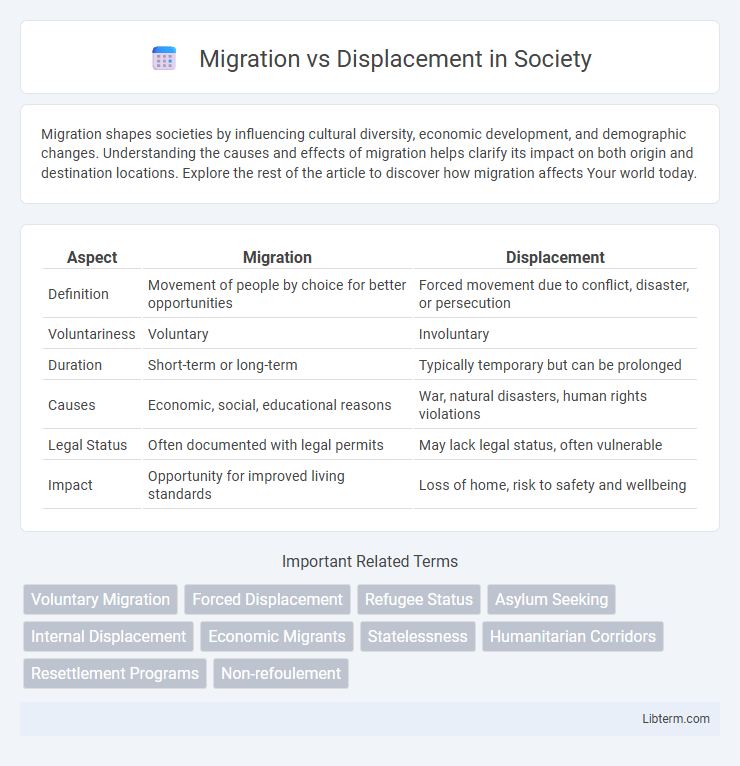Migration shapes societies by influencing cultural diversity, economic development, and demographic changes. Understanding the causes and effects of migration helps clarify its impact on both origin and destination locations. Explore the rest of the article to discover how migration affects Your world today.
Table of Comparison
| Aspect | Migration | Displacement |
|---|---|---|
| Definition | Movement of people by choice for better opportunities | Forced movement due to conflict, disaster, or persecution |
| Voluntariness | Voluntary | Involuntary |
| Duration | Short-term or long-term | Typically temporary but can be prolonged |
| Causes | Economic, social, educational reasons | War, natural disasters, human rights violations |
| Legal Status | Often documented with legal permits | May lack legal status, often vulnerable |
| Impact | Opportunity for improved living standards | Loss of home, risk to safety and wellbeing |
Understanding Migration: Definitions and Types
Migration involves the movement of people from one place to another, either within a country (internal migration) or across international borders (international migration), driven by factors such as economic opportunities, social connections, and environmental changes. Types of migration include voluntary migration, where individuals choose to move for improved living conditions or employment, and forced migration, resulting from conflict, persecution, or natural disasters. Understanding these distinctions helps in addressing policy needs and humanitarian responses effectively.
What Constitutes Displacement? Key Characteristics
Displacement occurs when individuals or groups are forced to leave their homes due to conflict, natural disasters, or persecution, distinguishing it from voluntary migration driven by economic or personal reasons. Key characteristics of displacement include involuntary movement, sudden onset, lack of choice, and the immediate threat to safety and well-being. Displaced populations often face temporary or protracted instability, limited access to resources, and heightened vulnerability compared to voluntary migrants.
Causes of Migration: Voluntary and Involuntary Factors
Migration occurs due to voluntary factors such as economic opportunities, education, and family reunification, while displacement results from involuntary causes like armed conflict, natural disasters, and persecution. Economic instability, political oppression, and environmental degradation are primary drivers forcing millions to abandon their homes unwillingly. Understanding these distinct causes aids policymakers in addressing migration with targeted humanitarian and development strategies.
Displacement Drivers: Conflict, Disaster, and Development
Displacement is primarily driven by conflict, disaster, and development projects that force populations to leave their homes involuntarily. Conflict-related displacement arises from violence, persecution, and threats to personal safety, often resulting in refugees and internally displaced persons. Disaster-induced displacement occurs due to natural hazards like floods, earthquakes, and hurricanes, while development-driven displacement stems from infrastructure projects such as dams and urban expansion, disrupting communities and livelihoods.
Legal Distinctions: Migrant vs. Displaced Person
Migrant status is generally defined by voluntary movement across borders for reasons such as employment, education, or family reunification, whereas displaced persons are forced to leave their homes due to conflict, persecution, or natural disasters and often fall under international protection frameworks. Legal distinctions hinge on the degree of choice and the nature of protection; migrants typically seek visas or work permits, while displaced persons may qualify for asylum or refugee status under instruments like the 1951 Refugee Convention. This differentiation affects access to rights, responsibilities, and state obligations, with displaced persons granted special protections due to their involuntary movement and vulnerability.
Social and Economic Impacts of Migration
Migration significantly influences social and economic structures by reshaping labor markets and cultural demographics. Migrants contribute to economic growth through skill diversification, entrepreneurship, and increased consumer demand, while also challenging public services and social integration frameworks. Social cohesion can be strained or strengthened depending on policy responses, with effective integration fostering community resilience and economic innovation.
Humanitarian Consequences of Displacement
Displacement frequently results in severe humanitarian consequences, including loss of shelter, disrupted access to healthcare, and increased vulnerability to exploitation and violence. Unlike voluntary migration, displacement is often sudden and forced, leading to overcrowded refugee camps and strained resources. Humanitarian responses must prioritize immediate protection, psychosocial support, and sustainable solutions to address these critical needs.
International Frameworks and Protection Mechanisms
International frameworks such as the 1951 Refugee Convention and the Global Compact for Migration establish distinct protection mechanisms for migrants and displaced persons, emphasizing legal status and rights. Refugees, defined under international law, receive specific protections including asylum and non-refoulement, while migrants are generally subject to national immigration laws with less comprehensive safeguards. Humanitarian organizations and UN agencies coordinate efforts to address both voluntary migration and forced displacement, ensuring tailored assistance within established legal mandates.
Migration and Displacement in Global Demographics
Migration involves the voluntary or planned movement of people across regions or countries, contributing significantly to shifts in global demographics by influencing population density, cultural diversity, and labor markets. Displacement, often caused by conflict, natural disasters, or persecution, results in forced movement, leading to sudden and large-scale demographic changes that strain resources in host areas. Understanding the distinctions between migration and displacement is crucial for policymakers to address the challenges and opportunities in international population dynamics effectively.
Addressing the Future: Policy Responses and Solutions
Effective policy responses to migration and displacement emphasize sustainable development, human rights protection, and international cooperation to address root causes such as climate change, conflict, and economic disparity. Integrating comprehensive frameworks like the Global Compact on Migration and the Global Compact on Refugees enhances coordinated efforts among governments and organizations to manage mobility while ensuring protection and inclusion. Investment in community resilience, legal pathways, and infrastructure supports both displaced populations and host societies, promoting long-term stability and socio-economic integration.
Migration Infographic

 libterm.com
libterm.com